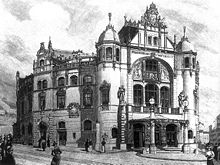Alexander Graf (architect)
Alexander Graf (born December 22, 1856 in Vienna ; † June 11, 1931 there ) was an Austrian architect of late historicism .
Life

Graf was born in 1856 as the son of the Viennese confectioner Alexander Graf (1859-1899) and his wife Karoline (née Marksteiner; † 1885). From 1873 to 1881 he studied architecture under Heinrich Ferstel and Karl König at the Vienna University of Technology .
From 1881 he worked as an architect in the Fellner & Helmer office before settling in Vienna as a freelance architect after a one-year study trip to Italy in 1888. The first orders were villas and residential buildings in Vienna and Merano. In doing so, Graf was guided by late historicism. He quickly gained great fame when he was commissioned to build the Kaiser-Jubilee Stadttheater. The jury had decided in favor of the project by Graf's former employer Fellner & Helmer, the property developer, an association, but nevertheless commissioned Graf to carry out the execution, albeit on the condition that they work with a second architect. Graf chose the former employee in the Fellner & Helmer office, Franz Freiherr von Krauss. The fame associated with the order helped Graf subsequently to get orders for the execution of a number of city theaters in the neo-baroque style, but also of residential houses and villas.
After the First World War, Graf hardly succeeded in acquiring any orders and he got into financial hardship. Graf's situation only improved when the municipality of Vienna started building residential complexes in the 1920s. In the years 1924 to 1929 he was able to build three houses for the community. At the end of the 1920s, Graf fell seriously ill and was barely able to work. In a letter from 1929 to the city council, the cooperative of visual artists asked for the granting of an "ongoing gift of grace or honorary pension" for the architect who had been "almost unable to work for some time".
Works
- around 1893: House on Waisenhausgasse, Vienna (today Boltzmanngasse; with Max Schindler von Kunevale )
- 1893–1895: Villa Angerer, Angererweg 77, Pörtschach am Wörthersee
- around 1895: Cooperative house of the shoemakers in Vienna, Florianigasse, Vienna
- around 1895: “Schwalbenvilla” for Rosa Lohner, Meran- Untermais , Franz-Innerhofer-Straße 1
- 1898: Kaiser-Jubiläums Stadttheater, Währingerstraße 78, Vienna (with Franz Krauss, today Volksoper Vienna ; heavily changed)
- 1902: “Glashüttenhof” residential and commercial building, Liechtensteinstrasse 22, Vienna
- 1906/07: Theater in Mährisch-Ostrau, Moravia
- around 1908: City Theater Aussig, Bohemia
- 1909–1911: Laibach City Theater, Krain
- before 1908: City Theater in Znojmo, Moravia
- before 1910: Villa Dr. A. Bösch, Billrothstraße 73, Vienna
- 1911–1912: Villa, Hockegasse 91, Vienna
- 1924: House, Troststrasse 64–66, Vienna (with Clemens Kattner )
- 1927: House, Graumanngasse 33, Vienna (with Hans Seitl )
- 1929: Residential house, Weissgerberlände 24, Vienna
literature
- Alexander Graf . In: Ulrich Thieme , Fred. C. Willis (Ed.): General lexicon of visual artists from antiquity to the present . Founded by Ulrich Thieme and Felix Becker . tape 14 : Giddens-Gress . EA Seemann, Leipzig 1921, p. 480 ( Textarchiv - Internet Archive ).
- Architect Alexander Graf . In: Monthly publication of the Wiener Bauhütte , 1931, No. 6, No. 7
Web links
- Alexander Graf. In: arch INFORM .
Individual evidence
- ↑ a b Alexander Graf. In: Architects Lexicon Vienna 1770–1945. Published by the Architekturzentrum Wien . Vienna 2007.
- ↑ a b Alexander Graf (architect) . In: General Artist Lexicon . The visual artists of all times and peoples (AKL). Volume 60, Saur, Munich a. a. 2008, ISBN 978-3-598-22800-1 , p. 66.
| personal data | |
|---|---|
| SURNAME | Count, Alexander |
| BRIEF DESCRIPTION | Austrian architect |
| DATE OF BIRTH | December 22, 1856 |
| PLACE OF BIRTH | Vienna |
| DATE OF DEATH | June 11, 1931 |
| Place of death | Vienna |

